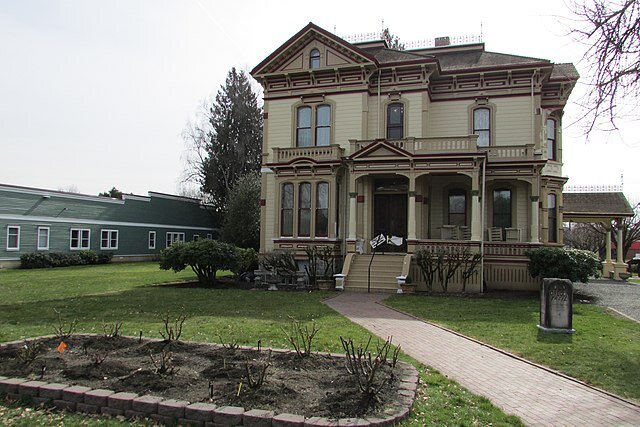Date of Establishment
The Meeker family, Ezra, and Eliza were pioneers in the establishment of the City of Puyallup. Their mansion construction began in 1886 and finished in 1890, and today is a nationally recognized Puyallup landmark that is being restored. From 1914 to 1969 the mansion served as a GAR retirement/nursing home before being closed for good. In 1973 the Puyallup Historical Society stepped in and stopped the planned burning of the building, and started restoration efforts.
After the Meeker’s passed they left the mansion for their daughter to “dispose” of as they saw fit. In 1912 the building was leased to serve as a hospital, but that didn’t last very long. The building was turned into a home for orphans and widows by 1915 and served as such for some time. By 1948 the building needed serious over-hauling and major remodelings were underway, leaving the building to be sold to a nursing home.
The buildings final owner is the Puyallup Historical Society, which currently still operates it as a museum. Over time restorations have brought this historic building back to its original state. These steps continue to this day to help preserve its historical value.
Name & Location
Though Meeker Mansion does not share in having tons of nicknames the mansion is for a significant historical site. Still standing in the heart of downtown Puyallup’s, is a must-see for any visitors to the town. Puyallup Historical Society was formerly known as the Ezra Meeker Historical Society before the 19th century.
Physical Description

The exterior of this Victorian-style building features white siding and ornate wooden trims. The front porch is spacious and has a 2nd-floor balcony above it, with another matching it on the east side of the house. Porches and balconies have decorative wooden railings and pillars, as well as the original front porch posts.
Inside this 2-story mansion were 15 rooms, 6 fireplaces, custom gold leaf molding, and 12-foot ceilings. There are speaking tubes and gaslights fitted throughout the entire house, as well as matching metal decorative fittings. Bathrooms are fitted with interior plumbing, marble fixtures, tin bathtubs, and beautiful wooden trims. Almost every type of wood can be found in this house. Ash and walnut frames, teakwood flooring, cedar paneling, redwood library, walnut panels, cherry wood posts, and the list goes on as you look at this house. No detail of elegance was spared during its construction.
Origin
Ezra Manning Meeker was an Oregon Trail pioneer, known as the “Hop King of the World. He became the girts mayor of Puyallup, Washington, and worked to memorialize the Oregon Trail that he traveled through-out his youth. The Meeker family first settled in Puyallup in 1862 and lived out their lives growing hops for brewing beer, as well as numerous other ventures. Meeker fell in on one of his many re-tracings of the Oregon Trial trips, shortly after dying on December 3, 1928, at the age of 97. The Meeker Mansion Museum details Ezra’s life story as well as his detailed experiences of the Oregon Trail.
Mythology and Lore
The Meeker Mansion is rumored to hold a multitude of restless spirits that haunt its walls. Sightings of the founder’s spirits are heavily reported, sometimes in realistic form and others as full-on phantom figures. There are also heavy reports of an overwhelming perfume smell that strongly takes over suddenly. This is said to be the presence of Eliza Meeker’s ghost passing by you.
One personal account of the haunting of Meeker Mansion reported being approached by the Meeker couple within 10 minutes of being in the master bedroom. She goes on to say Eliza Jane showed her an “evenings of quiet companionship in their lamp-lit bedroom”. Eliza even shared details of how the restorations were wrong, and which maids she didn’t care for. Lynne goes into great detail on her experiences with the spirits of the former owner in her Paranormal Blog.
Modern Pop-Culture References
Books & Literature
- Meeker Mansion Mysteries: A Fiction Anthology by Northwest Writers (1994)
Television Series
- Travel Channel’s “Mysteries at the Castle” (2014- )
Index
- Seattle Terrors
- Meeker Mansion Museum
- Puyallup Washington
- Lynne Sutherland Olson’s Paranormal Blog
- Definition.org
Is there anything we missed about Meeker Mansion? Let us know in the comments section below!


